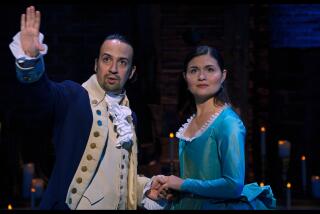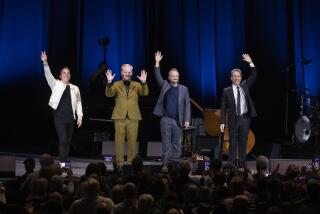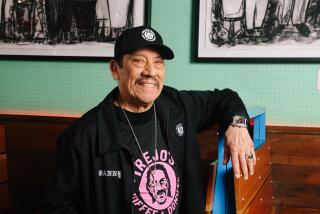Comedy Central’s ‘Drunk History’ under the influence of the past
- Share via
It’s a warm spring day in downtown Los Angeles, but inside the gloomy Palace Theatre it’s 1926 Detroit and actor Ken Marino is playing Harry Houdini as he dies onstage.
Literally dying — staggering and heaving, attempting card tricks and failing and finally stumbling and falling down, uttering his final words to his wife, Bess.
And here is where you realize this isn’t the filming of a standard biopic. As Marino performs Houdini’s death, he must work to lip-sync his dialogue to a prerecorded soundtrack played over speakers in the theater. And the voice providing that dialogue and the accompanying narration is both slurred and sometimes nonsensical.
This is “Drunk History.”
PHOTOS: Hollywod backlot moments
The series, which debuts Tuesday on Comedy Central, began life as a Web short produced and released through Will Ferrell and Adam McKay’s Funny or Die website. The concept is as irresistible as it is hard to explain: Find someone with a passion for a little-known bit of history, get them thoroughly liquored up and then allow them to attempt to tell the story.
To make things more interesting, an all-star cast reenacts the historical proceedings, but allows the drunk narrator to provide both framework and the dialogue.
“We wanted to tell stories that took these iconic figures from our history and humanized them,” says “Drunk History” host Derek Waters, who created the series with director Jeremy Konner.
In the series actors such as Jack Black, Kristen Wiig, Adam Scott, Jack McBrayer, Winona Ryder and Alfred Molina embody real-life historical figures, including Elvis Presley, Richard Nixon, Arthur Conan Doyle and Patty Hearst. The inebriated narrators are comedians and friends of the filmmakers.
Each of the eight episodes of the show’s first season link the historical vignettes through the American city where they took place: Chicago sees the stories of the Haymarket riot and the rise and fall of Al Capone; Washington, D.C., gets reenactments of the Watergate scandal and the rivalry between presidential assassin John Wilkes Booth and his brother, Edwin.
The shorts originated from a debate about Otis Redding’s 1967 death that Waters had with a friend one night over beers. His friend argued passionately and drunkenly that Redding knew he was going to die before boarding the plane that would soon crash into a Wisconsin lake.
PHOTOS: Celebrities by The Times
“People get drunk and talk about music all the time,” Waters says. “But what’s something they don’t normally get drunk and talk about? History.”
Though the Web shorts were shoestring affairs, shot mostly in the backyards of friends, the TV budget allows for greater use of locations. However, it’s still not on the level of an HBO, or even a History channel, miniseries. For Konner, the deliberately flawed reenactment vibe is important.
“It’s funny to tell people whose job it is to make things look perfect to stop making them look perfect,” Konner says.
The 21 vignettes of the first season were shot in 21 different locations over 21 shooting days, with each vignette featuring different actors, different time periods and different shooting styles. It was a whirlwind production, especially when not all the actors immediately understood the conceit.
“I have to be honest, I didn’t quite imagine it correctly when I first heard of it,” Molina says. “I got the idea that all the actors were going to be drunk or all the characters were drunk or we’d pretend to be drunk or something. But then I saw a clip and got it. I’m asked to do things a director has never asked me to do. For instance, being asked to deliver a line as though you have absolutely no idea why it’s there.”
While the actual shooting was tricky, it was just half the challenge. Waters also had to finesse, coerce and sometimes force workable historical narratives from his inebriated would-be historians, spending hours with them as they imbibe their alcoholic drink of choice.
PHOTOS: Memorable TV series finales
“I’ve learned so much psychology doing this.” Waters says. “But it’s not about people being drunk. The comedy comes from passionate people having trouble articulating the thing they’re passionate about.”
A show that displays a passion for history and education may seem an odd fit for Comedy Central, but it’s not as though cable programming makes a lot of sense these days.
“If you go on History channel right now, it’s six hours of ‘Pawn Stars,’” says Konner. “TLC, you’ll get ‘Toddlers and Tiaras.’ All of those traditional outlets for any kind of educational television are gone. If we can fill that slot in a funny way, I’m more than happy.”
Throughout the series, Waters appears in modern day, attempting to connect these bits of history to our current culture. What absurd bits of modern life would not be possible without the struggles of the past?
“I want to tell stories someone can learn from,” Waters says. “But if you don’t have the drunk aspect, then you’re preaching. If you can make people laugh, then you can really say what you want to say.”
As Waters whispers in the back row of the theater, Marino, wearing a tux, takes a dive from the stage as Houdini enters his final moments.
-------------------------------
‘Drunk History’
Where: Comedy Central
When: 10 p.m. Tuesday
Rating: TV-14-L (may be inappropriate for viewers younger than 14, with an advisory for language)
More to Read
The complete guide to home viewing
Get Screen Gab for everything about the TV shows and streaming movies everyone’s talking about.
You may occasionally receive promotional content from the Los Angeles Times.







